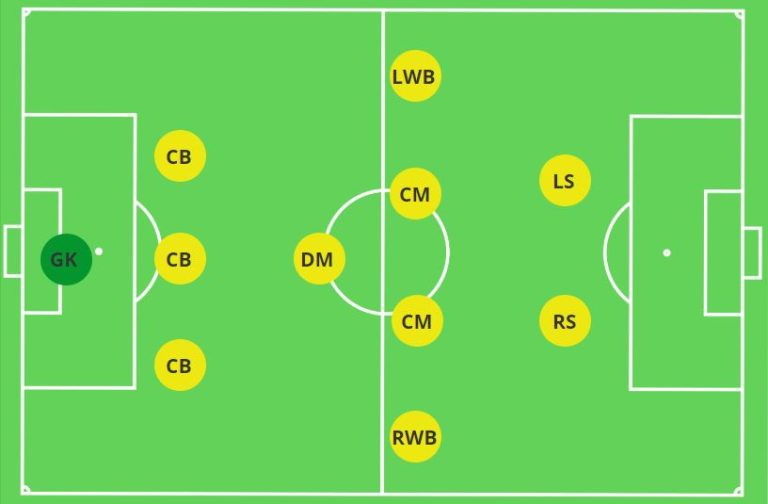Football in 2025 is defined by tactical innovation, positional intelligence, and a deep understanding of player movement. Coaches are using advanced systems that merge attacking creativity with defensive discipline, creating flexible structures that adapt to the rhythm of every match. From the fluid 4-3-3 to the compact 3-2-2-3, modern formations emphasize balance, pressing intensity, and controlled possession that turns defense into attack within seconds.
Top European clubs like Manchester City, Real Madrid, Bayern Munich, and Inter Milan have shaped how formations evolve, showing that success now depends on spatial awareness and transitional speed. The 4-2-3-1 and 3-4-2-1 systems remain dominant because they allow quick build-up play, strong defensive coverage, and room for midfield creators to dictate the tempo. In contrast, newer setups like the 3-1-4-2 and 4-1-2-3 give teams more flexibility to switch shapes mid-game, overwhelming opponents with fluid positioning.
In 2025, football formations are no longer static blueprints but living systems molded by analytics, player intelligence, and in-game adaptability. Each formation tells a story of strategy, movement, and control, making it a vital element in how the world’s best teams win matches and redefine the modern game.
Top Ten Best FootBall Formations In 2025
10. 4-4-2

The 4-4-2 remains a strong tactical setup in 2025 because of its shape and clarity. Two compact lines of four give defensive protection, while two strikers stay ready to stretch opposition defenses. This formation works best for sides that rely on discipline, pressing structure, and direct transitions. Midfielders hold narrow positions to protect the center, allowing fullbacks to push forward for width. In attack, the strikers combine quickly, often supported by late midfield runs. The simplicity of the 4-4-2 helps teams maintain control under pressure and shift easily between defense and counterattack.
Modern coaches adapt it by turning one striker into a deeper playmaker and by rotating wide midfielders inside when building play. Its biggest advantage lies in stability and compactness, which makes it difficult to break down. The main challenge comes when facing possession-based systems that overload central areas. In today’s game, it remains valuable for clubs that emphasize structured defen
The 3-5-2 formation thrives on balance between defense and creativity. Three center-backs stay compact, while wing-backs control width and stretch the field. This shape allows midfield dominance through numerical advantage, enabling teams to dictate possession and win second balls. The midfield trio typically includes a defensive anchor, a creative distributor, and a high-energy box-to-box runner. With two forwards ahead, the team always maintains an attacking presence, combining direct passing with coordinated pressing.
Modern interpretations focus on overlapping runs from the wing-backs and fluid rotation between midfielders to maintain control. The 3-5-2 suits teams that value structural organization yet still want attacking flexibility. When executed properly, it prevents isolation in wide areas and offers continuous support in buildup play. The biggest challenge is the physical demand on wing-backs, who must attack and defend with intensity. Coaches favor it in 2025 because it adapts easily to counterattacks or sustained pressure phases, offering stability, fluid movement, and numerical superiority in midfield.
8. 4-3-3

The 4-3-3 formation continues to define modern football tactics. Three midfielders create a triangle that connects defense to attack, giving fluid transitions and control of central spaces. Fullbacks overlap to add attacking width, while wingers stretch play or cut inside to combine with the striker. The single forward leads pressing movements, forcing defensive errors and recovering possession high up the pitch. Midfield balance remains the key feature: one holding player protects the defense while the other two advance to support attacks.
This structure promotes fast circulation of the ball, positional discipline, and controlled high pressing. The 4-3-3 is effective for teams emphasizing possession, creativity, and vertical passing patterns. It remains one of the most used shapes in European football because it offers both attacking width and defensive compactness. When properly coordinated, it delivers precision and intensity across every phase, making it one of the most efficient systems in 2025 football formations.
7. 4-1-4-1

The 4-1-4-1 is designed to control space and neutralize counterattacks. A single defensive midfielder shields the back line, allowing fullbacks to advance with confidence. Ahead of that anchor, four midfielders form a balanced structure capable of pressing collectively or transitioning quickly into attack. This shape provides defensive coverage while maintaining fluid movement across central areas. The striker’s role involves linking play, creating movement, and finishing when midfielders advance.
The midfield line shifts in unison, ensuring width and maintaining defensive compactness. In possession, teams build through short passes, using the central pivot as a link between defense and attack. Out of possession, the structure drops into a compact block, closing central channels and forcing opponents wide. The 4-1-4-1 suits teams that rely on positional play and patient buildup while ensuring that defensive balance remains intact. It’s efficient in both high pressing and deep defensive phases, combining control, structure, and vertical transitions.
6. 4-1-3-2

The 4-1-3-2 focuses on central control and continuous attacking presence. A holding midfielder anchors the formation, providing security and linking defense with three creative midfielders. These midfielders advance to support two forwards who maintain constant pressure on defenders. This system encourages compact buildup, quick vertical passes, and aggressive pressing immediately after losing possession. The 4-1-3-2 allows teams to dominate middle zones while keeping dual attacking threats ready to exploit space.
The defensive midfielder must anticipate play, cut off counters, and recycle possession efficiently. Fullbacks push forward to offer width, letting midfielders stay closer to the strikers for quick combinations. This layout gives freedom to attacking players while retaining defensive organization. It is widely favored in 2025 for its ability to transition seamlessly between phases and maintain intensity without sacrificing structure. It rewards tactical discipline, intelligent pressing, and sharp movement in advanced positions.
5. 4-2-3-1

The 4-2-3-1 remains among the most balanced modern football formations. Its double pivot of two midfielders secures defensive zones and initiates buildup, while the trio ahead brings creativity and pace. The attacking midfielder plays a central role, connecting the wingers and striker with precise passes. Wingers in this setup cut inside to threaten goal or create openings for overlapping fullbacks. The lone striker must combine strength, movement, and awareness to keep defenders occupied.
This system promotes structured buildup and sustained control of possession. It also adapts well to pressing, as the front four can quickly close down opposition buildouts. Defensively, the two holding midfielders close gaps and intercept counters. The 4-2-3-1’s flexibility suits teams that need to adjust mid-match between defensive compactness and attacking aggression. It remains a key reference point for coaches looking to balance creativity with positional discipline in modern football.
4. 3-4-3

The 3-4-3 is recognized for its attacking fluidity and defensive versatility. Three center-backs build from the back, while two wing-backs stretch play and link with midfielders. The central midfield duo connects the back line to the front three, ensuring transitions remain smooth. In attack, wide forwards exploit half-spaces and combine with the striker, creating unpredictable movements that pull defenses apart. The wing-backs contribute both width and pressing intensity, essential to sustaining control in modern football systems.
The shape allows compact defending while keeping at least five players ready to advance in attack. Teams using this structure press aggressively to recover possession in advanced zones and transition quickly into scoring positions. The 3-4-3 is especially powerful for sides that prioritize ball circulation, positional awareness, and fast recovery. It provides an ideal balance of risk and control, making it one of the most dynamic setups in 2025 football strategy.
3. 3-1-4-2

The 3-1-4-2 has grown in importance for coaches seeking central superiority and direct attacking options. A defensive midfielder shields the back three, while four midfielders stretch the pitch horizontally and support quick passing combinations. The two forwards stay high to keep pressure on defenders, forcing constant adjustments in the back line. This formation allows dominance in central areas and fast vertical transitions when possession changes.
The single pivot acts as a stabilizer, maintaining balance and distributing intelligently to progress play. The midfield four supports both defense and attack, while the wing players push high to provide outlets for switches of play. Teams using the 3-1-4-2 create layered attacks that alternate between controlled buildup and sharp direct passing. It functions effectively against systems that overload the flanks or press aggressively. The setup promotes structured compactness, attacking depth, and adaptability in modern tactical play.
2. 4-1-2-3

The 4-1-2-3 offers a combination of width, control, and attacking tempo. The holding midfielder acts as the pivot that links every phase of play, while the two central midfielders move dynamically to support both ends. Three attackers stretch defensive lines, with wingers cutting in to create shooting angles or passing opportunities. The fullbacks complement this by overlapping to maintain constant width. This shape emphasizes fluid ball movement, vertical penetration, and quick positional rotations.
Defensively, the pivot screens the defense, closing gaps and preventing central breakthroughs. In possession, the formation encourages combinations that overload key zones and open passing lanes. The 4-1-2-3 is effective for teams that value structured pressing and fast transitions after regaining the ball. It rewards intelligent movement, quick decision-making, and technical precision. In modern football, it remains a benchmark for controlled attacking play and midfield stability.
1. 4-1-3-2

The 4-1-3-2 stands at the top in 2025 for its balance, pressure, and attacking coordination. The single holding midfielder organizes defensive shape while linking fluidly with the trio ahead. Those midfielders control transitions, sustain possession, and support the two strikers. The dual-forward system ensures constant movement, creating channels and forcing defensive errors. This setup encourages compact pressing and rapid counterattacks through the middle. Fullbacks advance to stretch width, enabling the midfielders to occupy attacking half-spaces. The defensive midfielder acts as the pivot point, maintaining structure and recycling possession. Teams using this shape achieve controlled aggression—pressing without losing balance. The 4-1-3-2 suits modern tactical demands because it integrates pressing intensity, possession control, and multi-directional attack. Its structure allows for adaptability against various opponents while keeping a strong attacking rhythm. This formation represents the essence of modern football efficiency and precision in 2025.

